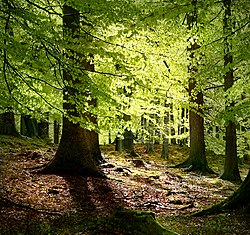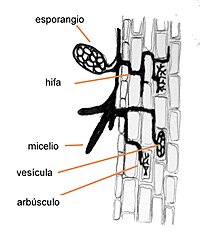
Back متعايشة فطرية جذرية Arabic Micorriza AST Mikoriza Azerbaijani Мікарыза Byelorussian Мікарыза BE-X-OLD Микориза Bulgarian মাইকোরাইজা Bengali/Bangla Mikoriza BS Micorriza Catalan Mykorhiza Czech



A mycorrhiza (Greek for fungus roots) is a symbiotic association between a fungus and the roots of a plant.[1][2][3]
In a mycorrhiza, the fungus lives inside the plant roots, and in the earth. The fungal hyphae are more efficient than plant roots at absorbing nutrients.[4]
Mycorrhizas are important for plant growth in many ecosystems. At least 80% of all land plant species (and over 90% of families) have mycorrhiza.[5][6] They depend on it for survival.[4] They are the most common symbionts in the plant kingdom: they involve about 6000 species of fungi and 240,000 species of plants.[6]
Mycorrhizas are divided onto two main types: ectomycorrhiza and endomycorrhiza. The hyphae of ectomycorrhizal fungi do not penetrate individual cells within the root, while the hyphae of endomycorrhizal fungi penetrate the cell wall and invaginate[7] the cell membrane.
The mycorrhizal symbiosis is ancient, dating to at least 400 million years ago.[8]
Wood Wide Web is a term used for mycorrhizal networks in forests.
- ↑ Kirk P.M. et al 2001. Ainsworth and Bisby’s dictionary of the fungi. 9th ed. CAB, Wallingford UK.
- ↑ Yong, Ed (14 April 2016). "Trees have their own internet". The Atlantic.
- ↑ Trappe, James M. (2005). "A.B. Frank and mycorrhizae: the challenge to evolutionary and ecologic theory". Mycorrhiza. 15 (4): 277–281. doi:10.1007/s00572-004-0330-5. PMID 15503185. S2CID 35720314.
- ↑ 4.0 4.1 Trappe J.M. 1987. Phylogenetic and ecologic aspects of mycotrophy in the angiosperms from an evolutionary standpoint. In Safir G.R. (ed) Ecophysiology of VA mycorrhizal plants CRC Press, Florida
- ↑ Wang B. and Qiu Y-L 2006. Phylogenetic distribution and evolution of mycorrhizas in land plants. Mycorrhiza 16: 299-363. [1]
- ↑ 6.0 6.1 Bonfante P. (2003). "Plants, mycorrhizal fungi and endobacteria: a dialog among cells and genomes". The Biological Bulletin. 204 (2): 215–20. doi:10.2307/1543562. JSTOR 1543562. PMID 12700157. S2CID 12377410. Retrieved 2009-07-29.
- ↑ push into, but do not penetrate.
- ↑ Remy W, Taylor TN, Hass H, Kerp H. (1994). "4-hundred million year old vesicular-arbuscular mycorrhizae". Proceedings of the National Academy of Sciences USA. 91 (25): 11841–43. doi:10.1073/pnas.91.25.11841. PMC 45331. PMID 11607500.
{{cite journal}}: CS1 maint: multiple names: authors list (link)